#wwf romania
Explore tagged Tumblr posts
Text
If you're ever mad at me, remember this is literally me. You're mad at a fucking cat


#wwf romania has some beautiful pics of carpathian lynx#also sam lore in case u didnt know: i say im a lynx cuz i was born with little tufts of hair on my ears#also national animal of romania
4 notes
·
View notes
Text
Herd of Bison Reintroduced in Europe Are Climate Heroes–Helping Store CO2 Equal to 43,000 Cars https://www.goodnewsnetwork.org/herd-of-bison-reintroduced-in-europe-are-climate-heroes-helping-store-co2-equal-to-43000-cars/
Just Imagine what they could do for the “Americas”!! Bring back bison!

“A recent study that looked at the effects of European bison on the ability of forests in Romania to store carbon found that these large animals have a ‘heroic’ effect.
By increasing the carbon storage potential of forests by 10%, it’s the equivalent of taking 54,000 US gasoline-powered cars off the road—and there are only 170 animals.
In 2014, WWF Romania reintroduced a herd of European wood bison into the Țarcu mountains that has grown from 100 to 170 head. Rooting around in the woods, scrub, and fields for their fodder, rolling around on the ground, and stomping, breaking, and squishing the landscape up with their hooves, are all important ecosystem mechanisms that have been absent for decades.”
#good news#bison#europe#eurpean bison#carbon sinks#carbon capture#carbon emissions#science#environment#nature#animals#conservation#climate change#climate crisis#rewilding#ecosystems#restoration#environmentalism#buffalo#tatanka
86 notes
·
View notes
Text
Csibi Magor vine la Audiențe
Csibi Magor vine la Audiențe
La o săptămână după ce știrea cu uciderea ursului Arthur a făcut înconjurul planetei, astăzi DNA a anunțat deschiderea unui dosar penal, in rem, cu privire la acest caz. Însă în spațiul public detaliile nu sunt pe deplin lămurite. Ministrul Mediului se declară convins că există totuși urși mai mari decât Arthur în România și neagă că ar fi existat informații despre caz în Minister înainte că…

View On WordPress
2 notes
·
View notes
Photo

Am urlat la lupi noaptea în Apuseni, ca să aflu cum trăim în pace cu animalele
În excursia asta am pus mâna pe un gard electric.
Citește tot aici: https://www.vice.com/ro/article/3kgmzy/am-urlat-la-lupi-noaptea-in-apuseni
0 notes
Link

Azi la Shonen Ro Live impreuna cu cei de la WWF-Romania donam bani pentru Australia, iar tu poti sa iti alegi unu din cele 5 premii. Si le aratam ca comunitatea anime din Romania face un bine. Dar si vorbim despre cele mai noi stiri din lumea anime, printre care: Demon Slayer cu Record Manga, Crunchyroll si cum a raspuns comunitatea la premiile anime. Multe ridiculozitati, stiri si jocuri! LIVE ACUM!
#shonen#shonen anime#shonenro#Shonen Romania#shonen ro#Shonen Ro Live#wwf#demon slayer#crunchyroll#crunchyroll anime awards#twitch#twitchtv#twitch streaming#Twitch Stream#anime#Romania#anime romania#Anime Podcast#podcast#iTunes podcast#video podcast#audio podcast#anime livestream#livestream#charity livestream#australia#bush fires
1 note
·
View note
Photo

Did you know that the Bison Reservation in Romania is one of the most sustainable destinations in the world?
#romania#travel#bison#wildlife#nature#wwf#rolandia#discover romania#tourist#tourism#traveler#travel the world#world places#reservation#animals#auroch#neamt#forest
12 notes
·
View notes
Photo

Posta Romana WWF 1984
0 notes
Text
Divers Discover Nazi Enigma Machine Thrown Into the Baltic Sea During WWII
https://sciencespies.com/history/divers-discover-nazi-enigma-machine-thrown-into-the-baltic-sea-during-wwii/
Divers Discover Nazi Enigma Machine Thrown Into the Baltic Sea During WWII
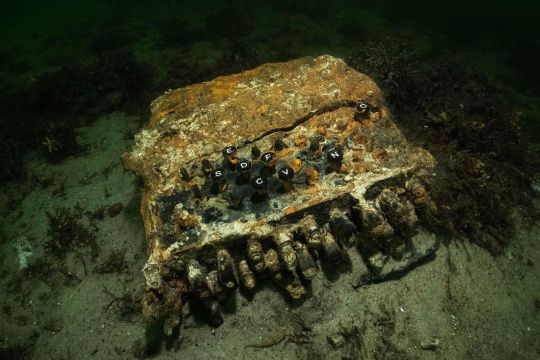
Last month, German divers scanning the Baltic seafloor for abandoned fishing nets happened upon a rare piece of history: a strange contraption with keys and a rotor, rusted and covered in algae but relatively intact.
“A colleague swam up and said: [T]here���s a net there with an old typewriter in it,” lead diver Florian Huber tells the DPA news agency.
Similar to a typewriter, the device was indeed used for sending messages—in this case, of a dangerous and clandestine variety. As Agence France-Presse reports, the group’s find is a rare Enigma cipher machine used by Nazi Germany to transmit encrypted military communications during World War II.
The divers found the machine off the coast of northeast Germany in the Bay of Gelting, which is part of the Baltic Sea. On assignment for the World Wildlife Foundation (WWF), the team had been using sonar technology to scan for “ghost nets,” or abandoned fishing nets that pollute the oceans and pose a deadly threat to fish, seabirds and other marine mammals, per a statement.
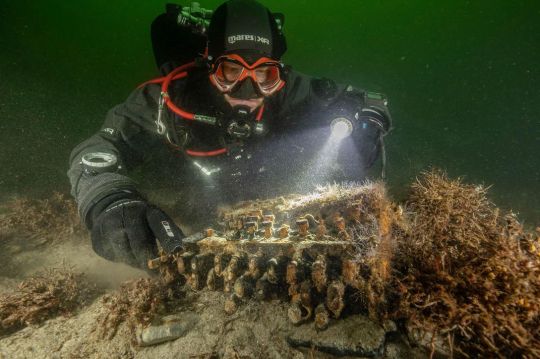
Divers happened across this WWII Enigma cipher machine while searching for abandoned fishing nets.
(World Wildlife Fund)
As Huber notes, the group’s sonar equipment often detects strange objects on the seabed.
“I’ve made many exciting and strange discoveries in the past 20 years,” he tells Reuters. “But I never dreamt that we would one day find one of the legendary Enigma machines.”
When users composed messages on Enigma machines, the devices’ rotors substituted new letters for each stroke in order to encrypt the message. Operators who received the encoded message would need an Enigma of their own, as well as the precise starting positions of the sender’s rotors, to decode the message, according to Stephanie Pappas of Live Science.
The machine discovered by the divers had three rotors, so it likely came from a German warship. U-boats—powerful submarines that wreaked havoc on Allied forces during the first and second world wars—usually carried more complex four-rotor Engima devices, historian Jann Witt of the German Naval Association tells the DPA.
In 1945, as the global conflict drew to a close, the German Navy purposefully sank a number of submarines in the Bay of Gelting to ensure they wouldn’t be handed over to the Allies, Huber explains in the statement. Someone might have thrown this machine overboard around that time to protect military secrets, Witt suggests.
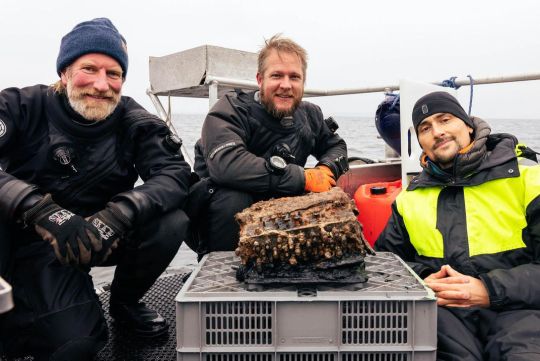
A team of German divers poses next to the Enigma cipher machine.
(World Wildlife Fund)
Though Enigma machines did, for a time, allow German forces to secretly communicate troops’ positions and plans of attack with impunity, the Allies eventually cracked their code.
Per BBC News, the Polish Cipher Bureau, including mathematicians Marian Rejewski, Henryk Zygalski and Jerzy Różycki, reconstructed a mock-up of the Enigma machine and made a first attempt at breaking the code in the late 1930s.
The Polish codebreakers’ efforts paved the way for subsequent research ventures, including British mathematician Alan Turing’s Bletchley Park team, which eventually cracked the increasingly sophisticated Enigma encryption. This achievement marked a major intelligence win for the Allies, and some historians estimate that it may have shortened the war by several years. Now recognized as a founder of modern computer science, Turing and his achievements were memorialized in the 2014 film The Imitation Game.
Germany produced about 20,000 Enigma machines during the 1930s and ’40s, but only a handful of these have survived to the present day, making the devices a prized collector’s item. In 2017, a mathematician in Romania sold a well-preserved three-rotor Enigma machine for roughly $51,620. Four-rotor Enigmas, meanwhile, have sold for upward of $400,000 at major auction houses.
Ulf Ickerodt, director of the archaeological office in Germany’s Schleswig-Holstein region, tells the DPA that the newly discovered Enigma machine will undergo cleaning after spending seven decades underwater. The contraption will then go on display at the local archaeology museum. All told, he says, the restoration process will take “about a year.”
#History
1 note
·
View note
Text
New Post has been published on JurnalulBucurestiului.Ro
New Post has been published on http://bit.ly/2soD7cT
Informatia Harghitei : Studiile ONG-urilor, plătite cu milioane de euro, nu au nici o aplicabilitate practică.
Ele nu prezintă situaţia reală în care se află carnivorele mari din România
Specialiştii susţin că din cauza refuzului Ministerului Mediului de a emite ordinul de derogare, au fost depăşite două perioade de vânătoare la urşi, timp în care numărul exemplarelor a crescut cu aproximativ o mie, la nivel naţional
Relatam într-un număr anterior despre întrevederea de la Consiliul Judeţean Harghita a factorilor responsabili din judeţ unde s-a decis, printre altele, înaintarea, către ministrul Mediului, a unei petiţii semnate de asociaţiile de vânătoare, proprietarii de terenuri şi asociaţiile de creştere a animalelor din mai multe zone ale ţării în legătură cu măsura nejustificată a neacordării de derogări legale pentru extragerea exemplarelor problemă şi a surplusului populaţiilor de urs, lup, râs şi pisică sălbatică.
Revenim de această dată cu argumentele specialiştilor şi, bineînţeles, ale celor afectaţi de optica oficială asupra acestei problematici: „Având în vedere consecinţele stopării totale a intervenţiilor asupra populaţiilor de urs şi lup – se spune în petiţie – vă rugăm să vedeţi concluziile specialiştilor noştri şi să le comunicaţi şi Academiei Române, concluzii care sunt: lSchimbarea etologiei speciilor de carnivore mari, care vor pierde în timp frica instinctivă faţă de om, dovedită prin cazurile recente concrete (a se vedea cele 4 atacuri de urs asupra omului numai în ultimele săptămâni din aprilie 2017, Harghita) l A dispărut toleranţa populaţiei locale faţă de aceste carnivore mari, ceea ce conduce la luarea de măsuri de retaliere faţă de carnivorele mari strict protejate de lege. Comunităţile locale deţinătoare de bovine şi ovine recurg la metode proprii de apărare l Paza efectuată de către gestionarii fondurilor cinegetice pe termen scurt va include inerent în continuare şi carnivorele mari, dar va fi o activitate tot mai grea l Prejudiciul plătibil la Stat în cazul uciderii de către om a unui urs este de 40.000 EUR l Prejudiciul plătit de către Stat în cazul uciderii, mutilării, schilodirii etc. a omului de către urs este 0 EUR, ceea ce este de neacceptat”.
„Gestionarii Fondurilor Cinegetice – se afirmă mai departe în documentul pentru care se strâng semnături în această săptămână – să cuantifice valoarea activităţilor depuse legate de carnivorele mari: paza, deplasări de orice fel (de intervenţie, de evaluare), asistarea pazei culturilor şi animalelor domestice, deplasări la pagubele deja ivite şi consemnate de comisii, etc. Valoarea cuantificată, care rezultă şi din condicile de serviciu ale paznicilor, să fie facturate către Ministerul Mediului!
Noi, Asociaţiile gestionare de Fonduri Cinegetice, cuantificăm suma ce ni se cuvine pentru paza carnivorelor mari (şi nu numai, ci toată activitatea depusă în caz de pagube), goane oarbe de îndepărtare, paza culturilor etc. la o sumă minimă modică de 10.000 EUR/an, acolo unde avem populaţie de urşi stabilă”.
Reamintindu-se că populaţiile de urs au crescut cu circa 1.000 de exemplare numai în perioada pentru care nu s-a acordat derogare, în document sunt inserate câteva întrebări la care ar trebui să răspundă ministrul Mediului, Graţiela Gavrilescu: „1. Mai intră în obligaţia gestionarilor orice activitate, acţiune, faţă de managementul acestor specii, inclusiv furnizarea datelor pentru estimarea populaţiei de carnivore? 2. Mai sunt obligaţi gestionarii să intervină în mod ��pompieristic” în cazurile de atac de urs asupra omului sau a bunurilor acestuia? 3. Este oportună cuantificarea şi prezentarea cererilor pentru despăgubire a valorii hranei complementare administrată pentru cervide şi mistreţi, hrană consumată aproape în totalitate de către urs? 4. Care ar fi metodele legale pentru unele acţiuni de îndepărtare a carnivorelor mari de la locurile de fătare a cervidelor şi a mistreţilor, sau din zonele unde se expune hrană suplimentară pentru acestea?”.
Totodată, apelul asociaţiilor de vânătoare, proprietarilor de terenuri şi crescătorilor de animale consideră că „se impune o analiză a studiilor făcute de către ONG urile mai jos-menţionate, care au fost finanţate în cadrul programelor LIFE şi nu numai, a modului cum au fost cheltuiţi banii publici şi europeni pentru finanţarea acestora. Finalitatea şi concluziile acestor studii au stat la baza deciziilor autorităţilor centrale şi au condus la situaţia actuală în care ne aflăm. Pentru noi, cei care gestionăm fauna cinegetică a României, aceste studii, plătite cu milioane de euro, nu au nici o aplicabilitate practică. Acestea nu au adus contribuţii de nici un fel la o mai bună gestionare a speciilor de carnivore mari. Ele nu prezintă situaţia reală în care se află carnivorele mari din România. Acestea nu au la origine o bază de date în măsură să conteste rezultatele studiilor de specialitate contractate de Minister. În cei 10 ani de când se fac aceste studii, aceste ONG-uri nu s-au prezentat la nici o procedură de achiziţie publică pentru contractarea studiilor de estimare a populaţiilor de carnivore mari. La gestionarii pe care îi reprezentăm, aceste ONG-uri (care au făcut proiecte pentru speciile urs şi lup) nu au fost prezente la lucrările de estimare din teren, cu toate că au fost informate şi/sau invitate cu fiecare ocazie).
ONG-urile la care ne referim sunt: WWF România, ACDB Vrancea, MILVUS şi Foundation Conservation Carpathia. Proiectele cu Fonduri Europene în cauză sunt LifeUrsus şi Wolflife”.
Specialiştii şi autorităţile participante la întâlnirea menţionată în primele rânduri consideră că prin emiterea unui ordin de derogare pentru 60 de exemplare, ce vizează urşii-problemă şi recoltarea preventivă, în toamnă, a altor 600 de exemplare la nivel naţional, situaţia s-ar normaliza. Chestiunea nu este totuşi, se pare, atât de simplă. Premierul Grindeanu tocmai povestea, adineauri, că un lot din autostrada Lugoj – Deva nu este gata din cauza suplimentării tunelurilor pentru urşi, într-o zonă fără urşi! Cum lotul respectiv face parte din Coridorul 4 European şi se construieşte cu bani de la Bruxelles, de la 108 milioane de lei, Comisia Europeană a suplimentat rapid fondurile la 220 milioane lei! Mai mult decât dublu! Eurocraţii şi puternicele asociaţii de protecţia animalelor din Occident, care n-au văzut urşi decât în poză, nu se lasă atât de uşor. Aşa se face că unii care şi-au exterminat urşii acum un secol vor să impună soluţiile lor utopice harghitenilor atacaţi (în ultimul timp) de urşi în propriile locuinţe. (M.G.)
#”carnivorele mari”#ACDB Vrancea#Foundation Conservation Carpathia#Gestionarii Fondurilor Cinegetice#harghita#informatia harghitei#LifeUrsus#MILVUS#nu au nici o aplicabilitate practică.#plătite cu milioane de euro#situatia reala#Studiile ONG-urilor#vanatoare la ursi#Wolflife#WWF Romania
0 notes
Text
More Forest protector NGOs you can donate to to help, these pages are in English 🇬🇧:
Carpathia
Euractiv
Euronatur
Forest protector NGO donation pages in Romanian 🇷🇴:
WWF Romania
Plantam fapte bune (translation: We plant good deeds)
Greenpeace
Thank you to everyone boosting this and lending a hand! Environmental rights are human rights ❤
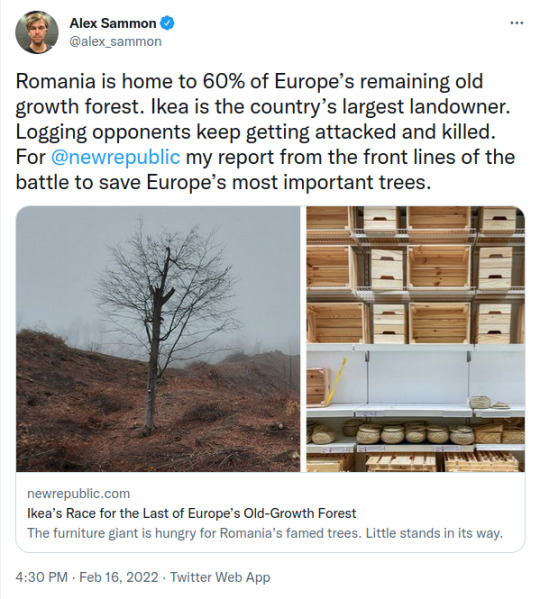
Not long after, they heard the whinge of engines; soon, two SUVs arrived. Out jumped not local police, but a horde: 15 men armed with bats and axes. The documentary crew broke for Bosutar’s car but couldn’t get the locks in time. The attackers pried the doors open, snapped the key, slashed the tires, and smashed the camera equipment. They beat Mocanu, trapped between the car and the mountainside, unconscious. They clubbed Dragolea in the face. The director dove down the nearby ravine, where he hid under the roots of a fallen tree and called the police, begging them to come with their sirens on. “I said, ‘They’re killing the journalists in the forest, and they are tracking me down,’” he recounted. “I knew cases where people had died in the forest, I saw axes around me. If someone didn’t call, we were going to die for sure.”
17K notes
·
View notes
Photo

The biggest hits of WWF-Belgium in 2021
Supported by 130,000 supporters, WWF-Belgium works hard to conserve wildlife.
Here are the biggest hits of 2021:
- In the heart of Europe, 95,000 ha of ancient and primary forests have been given legal protection thanks to WWF's policy advocacy work.
- Europe has proposed a law against imported deforestation This text follows up on the Together4Forests campaign, during which nearly 1.2 million citizens called for strong European legislation in this direction.
- Thirty-one orphan cubs saved in Romania: WWF-Belgium has supported the only orphanage for wild bear cubs in Romania for many years.
- Successfully reintroducing wild dogs in Malawi and Zambia in parks supported by WWF-Belgium.
- Almost no emblematic species such as elephants, lions and rhinos have been poached in the parks supported by WWF-Belgium in Zambia and Malawi.
- A new tigress was seen by surveillance cameras installed by WWF-Belgium in Mae Wong National Park, Thailand. The presence of this unknown female gives hope for an increase in the population of tigers in the country.
- Supported by WWF, 100 families from four indigenous communities in Ecuador have planted 73 hectares of sustainable, local cocoa.
- In Belgium, WWF protected 161 farms from wolf attacks.
- In the Semois, WWF restored 22 km of banks for the otter.
To find out more, consult the annual report of the Belgian association, a new edition produced again in collaboration with the communication agency #pageinextremis.
#pageinextremis has been supporting the WWF since 2009, notably by producing the annual report and the magazine of the Belgian section each year.
The environmental attention is a founding pillar of #Pageinextremis, which has been continuously operating for leading actors such as: - the United Nations Environment Programme (UNEP), - the European Environment Agency (EEA), - the Convention on the Conservation of Migratory Species of Wild Animals (CMS), - Greenpeace, WWF and many others.
Get in touch with us: inextremis.be
1 note
·
View note
Text
Idei de tehnologie Blockchain pentru a stimula dezvoltarea durabilă în Armeniș
În atmosfera minunată a Munților Tarcu, inițiativa de resălbăticire din Măgura Zimbrilor a găzduit timp de două zile un brainstorming, cu scopul de a dezvolta o idee viabilă care ar permite naturii și dezvoltării durabile să colaboreze mai bine, folosind caracteristicile unice ale tehnologiei blockchain: descentralizare, încredere, transparență.

WWF România s-a întâlnit cu Marcus Dap de la ETH Zurich (Universitatea Tehnică Federală din Zürich), Toni Caradonna și Roman Eyholzer, ambii de la Fundația Porini. Pentru a încuraja o atmosferă inovativă, la întâlnire a participat unul dintre internii din Taskforce-ul Măgura Zimbrilor, Danne Milo van Ronne, și Gelu Stoicănescu, un absolvent recent al Facultății de Finanțe și Matematică. Echipa WWF a fost reprezentată de Oana Mondoc, ghidul spre tehnologiile inovatoare în cadrul WWF România, Corina Gheorghiu, specialist în economie ecologică și Alina Floroi, un partener extern care oferă sprijin în cadrul proiectului tehnologic.

Sesiunea s-a încheiat cu o experiență de urmarire a zimbrilor condusă de rangerul Daniel Hurduzeu. Grupul a fost deosebit de norocos, deoarece participanții au reușit să vadă urme de zimbru, cerb, urs, râs și bursuc pe drum.

După ce au mers pe urmele zimbrilor, au auzit zgomotul lor într-o poiană. Rangerul a ghidat toată lumea în pădure pentru a merge în jurul zimbrului și a căuta un unghi bun pentru a-I vedea de departe. Câțiva membrii ai echipei au reușit să surprindă un grup de aproximativ 6 zimbri și doi viței înainte ca aceștia să fugă în pădure.

Ce implicații are munca depusă
Marcus și echipa sa de la ETH, inclusiv cadre universitare din întreaga Europă, dezvoltă un sistem de stimulare financiară nou, nuanțat și multilateral, pentru a promova o economie circulară, divizibilă și pentru a atinge obiective sociale prin colaborare. Fundația Porini este un mecanism de deschidere a drumurilor pentru aducerea technologiei blockchain în lumea conservării, stabilind soluția descentralizată a lanțului de sustenabilitate pentru a avea grijă de lumea naturală și alte obiective comune care fac parte din Obiectivele ONU de Dezvoltare Durabilă.
Tehnologia Blockchain permite colaborarea unor rețele mari de oameni care nu se cunosc neapărat între ei. Cheia acestei tehnologii stă în faptul că informațiile din sistem nu pot fi modificate de un singur participant. De asemenea, tehnologia permite oamenilor să ajungă cu ușurință la un consens.
Modul în care tehnologia blockchain poate acționa în platforma tech-nature care se dezvoltă în Armeniș se conectează cu nevoia de a activa părțile interesate pentru a aprecia importanța naturii și a înțelege că acțiunile pozitive au cu adevărat un impact.
O mulțime de proiecte legate de natură suferă din cauza lipsei de vizualizare și de înțelegere a impactului acestora. Aceasta este în special o frustrare pentru donatorii care doresc să știe dacă banii donați de ei au un efect.
Cum vedem viitorul
WildAI [eye] prevede creșterea impactului monitorizării vieții sălbatice, prin proiectarea unui sistem de inteligență artificială (AI) care conține dispozitive mici de urmărire GPS care pot fi montate pe zimbri, carnivore mari și alte mamifere mari. Acest proiect este o platformă de lansare pentru a produce instrumente rentabile pentru monitorizarea pe scară largă a speciilor sălbatice adaptate la terenul dificil din Carpați. Captarea automată a datelor de pe teren va contribui la crearea unui sistem care să permită o vizualizare exactă a stării de sănătate a ecosistemului.
Blockchain poate ajuta la alinierea intereselor zonelor sălbatice și bunăstarea localnicilor și va oferi un scenariu în care o dezvoltare armonioasă poate să ofere protecție faunei sălbatice. "Prin rezolvarea nevoilor naturale, rezolvăm nevoile sociale și viceversa", a fost viziunea exprimată în cadrul atelierului.

WildAI [eye] a stabilit o etapă de 6 luni pentru atingerea etapei MVP în domeniul monitorizarii hardware, a platformei GIS online și a instrumentelor blockchain.
WildAI [eye] este primul pilot al WWF-România ca "Panda Lab". Prin intermediul laboratoarelor Panda Labs, WWF lucrează cu tehnologie, business, design, mediul academic și conservare pentru a dezvolta noi abordări pentru a rezolva cele mai stringente probleme ale planetei noastre. Panda Lab va deveni acceleratorul descentralizat al WWF România, o comunitate de rezolvare a problemelor care are ca scop atragerea de parteneri și finanțarea treptată.
Urmariți dezvoltarea proiectului pe canalele WWF:
Facebook WWF Romania
Instagram
Twitter
Text: Alina Floroi
Fotografii: Alina Floroi, Toni Caradonna, Oana Mondoc
#BisonHillockLive#MaguraZimbrilorLive#bison#WildAI#Blockchain#AI#rewildingromania#rewildingeurope#pandalabs
2 notes
·
View notes
Text
ANUNT IMPORTANT VA ROG CITITI
Dragii mei, Shonen Ro Live o sa se mute Duminica de la ora 15 si o sa fie o editie speciala. Tot o editie special o sa fie si Ora de Anime de luni si Shonen Ro Live din data de 29. Plus un livestream surpriza in timpul saptamanii viitoare. De ce? Pentru ca lucram impreuna cu cei de la WWF-Romania pentru a aduna bani pentru a combate dezastrele si incendiile din Australia si pentru a ajuta mediul si animalutele afectate. O sa avem niste teluri in minte, o sa avem niste lucruri interesante de facut si challengeuri. Dar cel mai important lucru pe care o sa il facem, e sa donam si sa incercam sa adunam cel putin 100 de dolari pentru dezastrele si incendiile din Australia. Iar daca vreti sa donati, puteti face asta aici INCEPAND de MAINE: https://donate.tiltify.com/@shonenro/shonen-romania-charity-for-australia-is-burning
#shonen#shonen anime#shonenro#Shonen Romania#shonen ro#Shonen Ro Live#Ora De Anime Podcast#Ora de Anime#anime#Romania#anime romania#Anime Podcast#australia#bush fires#wwf
1 note
·
View note
Text
Peste 260 de copii din corurile Cantus Mundi sărbătoresc „Ora Pământului”
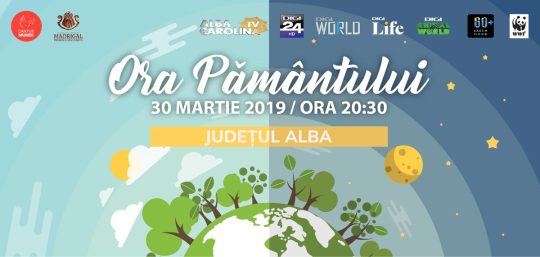
„Ora Pământului 2019” va fi sarbatorită de peste 260 de copii din corurile Programului National Cantus Mundi, care se vor reuni în fața Catedralei Reîntregirii Neamului din Alba Iulia. Copiii și tinerii, alături de coordonatorii corurilor, familii și prieteni, vor cânta pentru a aduce naturii și publicului mesajul lor de implicare și responsabilitate.

Începând cu ora 20:30, corurile de copii Cantus Mundi vor interpreta cântece special selectate pentru acest moment și, in același timp, se va întrerupe iluminatul în zona de organizare a evenimentelor. Programul Național Cantus Mundi organizează, la nivel național, evenimente muzicale cu ocazia „Orei Pământului”, în intervalul orar 20:30 – 21:30. Peste 12.000 de copii și tineri din corurile Cantus Mundi se vor reuni sub sloganul internațional al World Wide Fund for Nature (WWF) - „Conectează-te cu natura! Acum este momentul să acționăm!”. Vezi Elevi de nota 10 Sărbătorirea „Orei Pământului” inițiată de Cantus Mundi se va desfășura simultan în 85 de localități din 33 de județe din țară: Alba, Arad, Argeș, Bacău, Bihor, Brăila, Brașov, București, Buzău, Cluj, Constanța, Covasna, Dâmbovița, Dolj, Galați, Giurgiu, Hunedoara, Ialomița, Iași, Ilfov, Maramureș, Mureș, Neamț, Olt, Prahova, Satu Mare, Sibiu, Suceava, Teleorman, Timiș, Tulcea, Vâlcea și Vrancea.
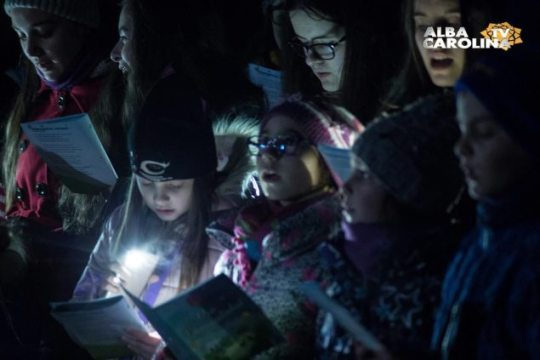
„Copiii României vor cânta într-un glas pentru sănătatea Pământului. Cantus Mundi este cel mai mare organizator de evenimente muzicale în cadrul Earth Hour 2019, acțiunile corale desfășurându-se în 81 de localități. Este un efort imens pe care echipa Madrigal-Cantus Mundi îl face și îi chemăm alături de acești minunați copii pe toți cei care înțeleg că România se va schimba prin vocile acestora.”, a declarat Emil Pantelimon, managerul Corului Național de Cameră „Madrigal – Marin Constantin”. Cea de-a patra ediție a evenimentului „Ora Pământului” realizată de echipa Cantus Mundi se va desfășura sub egida WWF, organizație care a lansat acest proiect în 2007, reușind să mobilizeze comunități din peste 180 de țări. Lista evenimentelor „Ora Pământului” organizate de către Programului Național Cantus Mundi va fi actualizată pe pagina de Facebook Cantus Mundi Romania periodic. Vezi si Seva de mesteacăn, remediu MIRACULOS împotriva cancerului Programul Național Cantus Mundi este cel mai mare program de integrare socială prin muzică din România, inițiat de reputatul dirijor Ion Marin și derulat cu sprijinul membrilor Corului Național de Cameră „Madrigal – Marin Constantin”. După 8 ani de activitate, Programul Național Cantus Mundi a adunat sub umbrela sa peste 1.150 de coruri. 43.000 de copii, alături de dirijorii lor, participă la promovarea cântului coral pe întreg cuprinsul țării, depășind barierele legate de etnie, condiție socială și capacități fizice sau psihice, construind astfel nuclee culturale complexe, atât de necesare pentru revitalizarea societății noastre. Read the full article
0 notes
Text
Romania's forests under mounting threat—along with rangers
https://sciencespies.com/environment/romanias-forests-under-mounting-threat-along-with-rangers/
Romania's forests under mounting threat—along with rangers


Romania’s woodlands are home to some of the last virgin forests in Europe and diverse wildlife species
Like thick wrinkles, a multitude of dirt roads cut through barren slopes in Romania’s mountainous Valea Rea region, showing the impact of aggressive illegal logging—which is not just threatening its rare forests but human life too.
In a recent escalation of violence, two rangers were killed within a month of each other in different parts of the country while trying to stop alleged timber thieves.
The latest tragedies have brought thousands of Romanians, including hundreds of rangers, into the streets to demand the government does more to protect the forests and their guardians.
Environmental groups say Romania’s woodlands, home to some of the last virgin forests in Europe and diverse wildlife species, are under threat. Greenpeace estimates that up to 20 million cubic metres of wood (700 million cubic feet) are illegally harvested each year.
Dominated by the Austrian company Holzindustrie Schweighofer, the timber sector is estimated to be worth more than six billion euros ($6.6 billion) in the EU member country, where forests cover some seven million hectares (17,300 acres), or almost a third of the country.
‘Very dangerous job’
But logging has disfigured many mountains and foothills, and rangers face threats and violence.
In October, a 30-year-old ranger in Maramures county in northern Romania was found dead with a bullet wound in his back, shortly after the father-of-three made a phone call to say he caught three people illegally cutting trees.

Romanians held placards reading “All for the forests” during a protest on November 3 against illegal logging
A month earlier, his 50-year-old colleague from Iasi county in the northeast was beaten to death with an axe. A 17-year-old has been arrested for murder.
Romsilva, the state company that manages the public forests, says 185 rangers have been hurt since 2014.
A dozen rangers interviewed by AFP say they have been beaten, chased or threatened while on duty at least once.
The average monthly wage of a ranger is just 2,000 lei (420 euros, $460), they say.
“It’s a very dangerous job, especially given the fact that I have to monitor a thousand hectares alone,” says Valentin Dirig, 43, who has been guarding the forests in Neamt in the northwest for 15 years.
Marinel Ivanescu, a ranger from Teleorman county in the south, denounces “overlapping interests” between local authorities and loggers in a country where 3.2 million households are heated with wood.

Forest guards stand next to wooden crosses bearing the names of their killed colleagues during a protest near the parliament building in Bucharest
Ancient forests under pressure
Forest sector crime generates up to 152 billion dollars a year globally, ranking fourth in terms of profitability after drug trafficking, counterfeiting and human trafficking, according to Sasha Braun of Interpol.
In Eastern Europe “the ancient forests that shelter many species of animals and plants are under strong pressure from organised crime groups,” Braun told a seminar hosted by the World Wildlife Fund (WWF) in Bucharest in late October.
A report by Romania’s Court of Auditors estimated in 2015 that 80 million cubic metres of timber worth $5 billion were illegally cut between 1990 and 2012.
In the Fagaras mountains, which peak at 2,544 metres (8,346 feet) in central Romania, hundreds of hectares of forests were cut between 2008 and 2012.
Authorities insist that after legislation was tightened in 2015, limiting the amount of wood that companies can log and allowing the gendarmerie to check trucks carrying timber, the phenomenon is now under control.

Two rangers were killed within a month of each other in different parts of the country while trying to stop alleged timber thieves
According to Romsilva, just 206,000 cubic metres were cut illegally in 2018, 31,000 from public forests.
Holzindustrie Schweighofer, the Austrian company that works with smaller Romanian timber suppliers, was investigated after a 2018 NGO report accused it of disregarding the wood’s origins, leading to police raids on its sites.
‘Deforestation out of control’
Private land ownership accounts for about half of all forests.
“The problem is with the private landowners who bought or recovered forests after the fall of the communist regime and think they can do whatever they want,” ranger Dirig says.
In 2015, the government commissioned expert Gheorghe Marin to carry out a forest inventory.
He and his team found 20 million cubic metres of wood that disappear yearly from the forests, compared to 19 million cubic metres that are cut legally, according to the report leaked to the media last month.

In the Fagaras mountains, hundreds of hectares of forests were cut between 2008 and 2012
Authorities have disputed the number. Marin told AFP that the inventory was suspended and that his contract was not extended.
Greenpeace also accuses the environment ministry of delaying the implementation of a national system to track wood transport, which would use satellite images and CCTV to monitor the forests and the trucks leaving it.
“Just look at the number of trucks carrying wood to understand that deforestation is out of control,” says Romania’s Greenpeace spokesman Cristian Neagoe says.

The timber sector is estimated to be worth more than 6 billion euros ($6.6 billion) in the EU member country
Radu Melu of the WWF says some companies use the same document, authorising one timber transport, for two different transports out of the forests.
In Romania’s Carpathian mountains in the Valea Rea region, forest engineer Midorel Badescu, 59, knows every path.
He says three private owners have been under investigation for several years over the barren slopes.
“It doesn’t matter if they are convicted or not,” he says. “I want them to be obliged to reforest the mountains.”
Explore further
Romanian forests face ‘acute’ illegal logging problem
© 2019 AFP
Citation: Romania’s forests under mounting threat—along with rangers (2019, November 18) retrieved 18 November 2019 from https://phys.org/news/2019-11-romania-forests-mounting-threatalong-rangers.html
This document is subject to copyright. Apart from any fair dealing for the purpose of private study or research, no part may be reproduced without the written permission. The content is provided for information purposes only.
#Environment
0 notes
Text
Romania: aumenta la paura a causa degli orsi
#Romania: aumentano notevolmente gli attacchi da parte degli #orsi e dei #lupi.
L’AUMENTO DEGLI ATTACCHI NEL 2017
L’AMP (Agenzia per la protezione dell’ambiente) ha registrato, dall’inizio del 2017, 73 casi di attacchi da parte di orsi. Il fenomeno ha interessato principalmente la Romania Centrale, più precisamente la contea di Harghita. Nel 2016 furono registrati 40 casi di attacchi, rivolti quasi unicamente al bestiame.
Quest’anno sette persone, invece, sono finite sotto…
View On WordPress
#aggressione#ambiente#bestiame#caccia#contea#Lupi#ministro#ordine#orsi#pascolo#pastori#protezione#Romania#wwf
0 notes